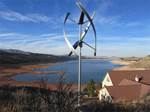China invested to become world SWT leader
A 2009 China Europe International Business School (Shanghai) project titled The Rural Electrification in China and The Impact of Renewable Energies details the government policies and multinational funding that has established China as the leader in small wind.
A 2009 China Europe International Business School (Shanghai) project titled The Rural Electrification in China and The Impact of Renewable Energies details the government policies and multinational funding that has established China as the leader in small wind. First came the central government’s goal of full rural electrification by 2020. Although extending the grid has been the backbone of its strategy, with minihydro power plants serving as a stop-gap measure until the grid extension is completed, this strategy is not economically competitive compared to off-grid renewable energy in remote locations, especially in the far west, where roughly 8 million people lack electricity.
Started in 1999, the Brightness Program relied on solar and wind applications to provide electricity to 23 million people in Gansu Province, Quinghai Province, Inner Mongolia, Tibet and Xinjiang by 2010, with the target capacity of 100W per person. Integrated with the Brightness Program, the second stage Township Electrification Program (2002-2005) was one of the largest renewable-energy-based rural electrification programs in the world with a total investment of $700 million (USD) supplied by both the central and local governments. In less than 20 months, it electrified more than 1,000 townships and supplied access to 1 million people in the areas previously mentioned, as well as Shaanxi, Sichuan, Hunan and Yunnan Provinces.
The third stage Village Electrification Programme (2006-2010) targeted bringing electricity to 20,000 villages in off-grid western regions. Launched in 2005, the China Renewable Energy Scale-up Program (CRESP) is funded by the Chinese government, the World Bank and the Global Environment Facility. It goes beyond rural electrification to demonstrate the feasibility of scaling up renewable technologies and the resulting economic and environmental benefits vs. coal-fired power generation. CRESP promotes the implementation of renewable energy policy development and invests in renewable energy companies and projects.
Related Content
-
JEC World 2023 highlights: Recyclable resins, renewable energy solutions, award-winning automotive
CW technical editor Hannah Mason recaps some of the technology on display at JEC World, including natural, bio-based or recyclable materials solutions, innovative automotive and renewable energy components and more.
-
Achieving composites innovation through collaboration
Stephen Heinz, vice president of R&I for Syensqo delivered an inspirational keynote at SAMPE 2024, highlighting the significant role of composite materials in emerging technologies and encouraging broader collaboration within the manufacturing community.
-
Honda begins production of 2025 CR-V e:FCEV with Type 4 hydrogen tanks in U.S.
Model includes new technologies produced at Performance Manufacturing Center (PMC) in Marysville, Ohio, which is part of Honda hydrogen business strategy that includes Class 8 trucks.















